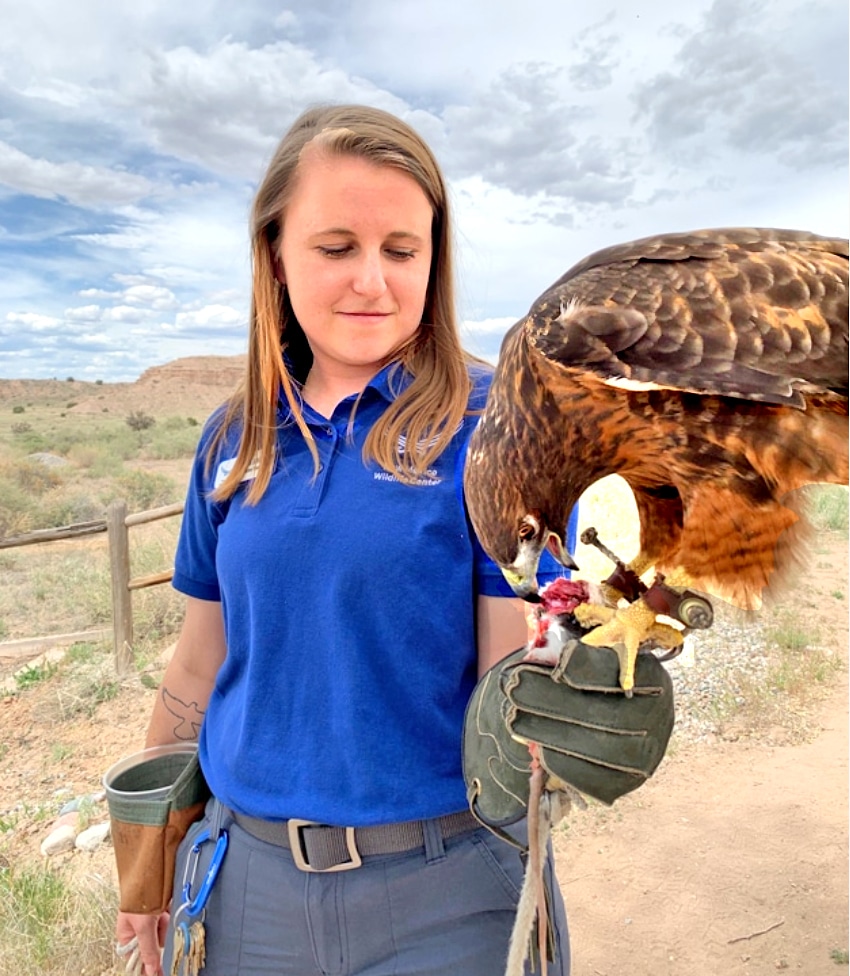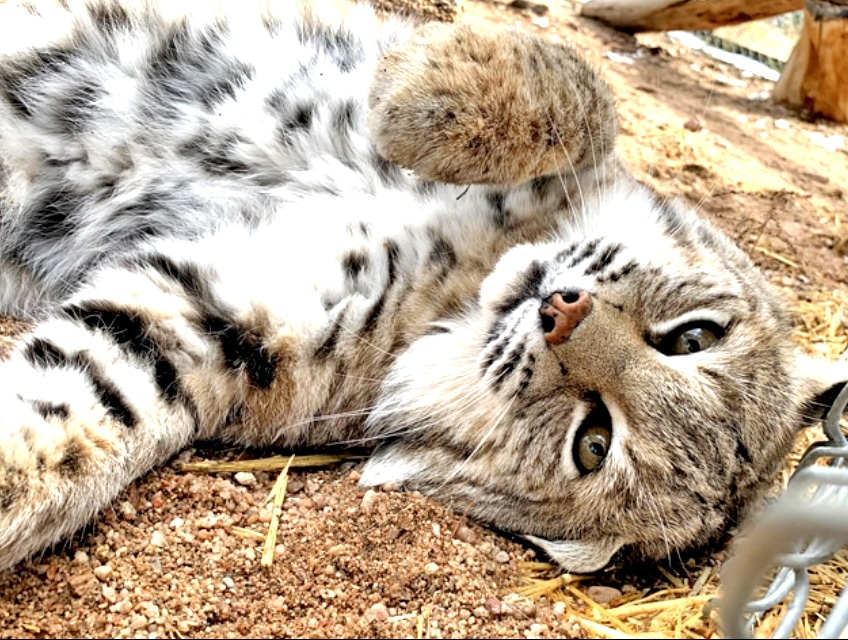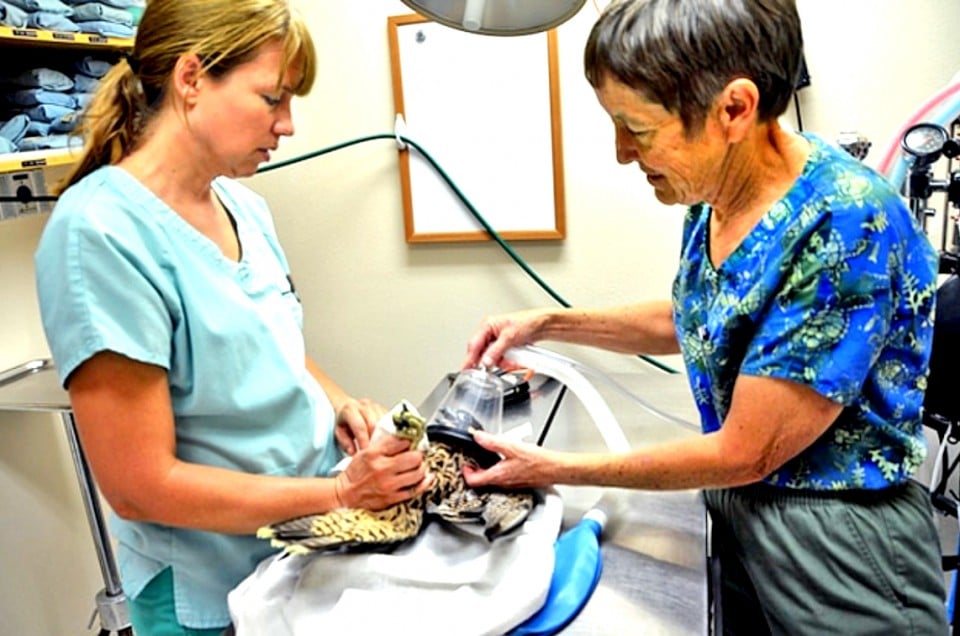 NMWC Site Manager and Volunteer Coordinator Jessica Schlarbaum and Cinder, a Red Tailed Hawk. Courtesy/NMWC
NMWC Site Manager and Volunteer Coordinator Jessica Schlarbaum and Cinder, a Red Tailed Hawk. Courtesy/NMWC
 Joni the bobcat is one of the New Mexico Wildlife Center’s non-releasable ambassadors. Courtesy/NMWC
Joni the bobcat is one of the New Mexico Wildlife Center’s non-releasable ambassadors. Courtesy/NMWC
By KIRSTEN LASKEY
Los Alamos Daily Post
kirsten@ladailypost.com
Some people may believe they need to hike deep into the mountains to see a bear, but in Los Alamos one need look no further than the sidewalks in Central Park Square.
There is no question that continual draught, wildfires and climate change are nudging bears and other wildlife out of their natural habitat and into urban areas in search of food. And neighborhood trashcans and dumpsters provide easy dining opportunities.
Land of Enchantment Wildlife Foundation Founder Dr. Kate Ramsay said once a bear learns to do something, they master the technique. So, if they get one positive re-enforcement with a trash can, they will be back.
Bears and other animals seem to be learning this practice. Los Alamos County Animal Shelter Manager Paul Sena said last year Animal Control responded to 130 calls dealing with wildlife.
He said that these calls only dealt with live animals. Sena said many calls were specifically for bears and this year’s calls are quickly matching last year’s numbers.
Sena said wildlife calls are dependent on weather circumstances. If there is an early frost or drought, he said animals will look for food elsewhere and if they formed a habit the previous season of foraging for food in trash cans, that behavior will continue.
His advice?
“Don’t provide a buffet for bears because they will come and eat,” Sena said.
Ramsay echoed that sentiment.
She praised Los Alamos County Council for approving $2.4 million in the FY2022 budget to purchase bear resistant roll carts and dumpsters for every residence and commercial business. Ramsay recognized Vice Chair James Robinson for his efforts in getting the budget item passed.
“Congratulations to Los Alamos County for being bear aware,” Ramsay said.
Ramsay called the purchase “one of the greatest things we can have happen to make the people in the community have the ability to live with wildlife … you are one of the elite in the U.S.”
The bear proof roll carts are just one way to prevent bears from coming into residents’ yards, Ramsay said. Bird feeders should be removed or taken in at night when bears are most active and fruit trees should be pruned or removed. Since water sources are incredibly important to bears, she said homeowners need to reconsider backyard ponds and other water features.
Ramsey said that Los Alamos residents need to get used to wildlife … after all, residents are in their turf.
Bears are not the only animals people need to be aware of. If a human comes face-to-face with animals there are things to keep in mind, said New Mexico Wildlife Center Site Manager and Volunteer Coordinator Jessica Schlarbaum.
“The one big thing we focus on is trying to encourage people to keep their distance … we encourage people to stay inside their homes or stay in their car … try and keep a barrier between you and the wildlife and we encourage people to keep an eye on their pets,” Schlarbaum said.
Schlarbaum said people need to keep an eye on their cats, which can be both predator and prey. Also, homeowners can make their yards as inhospitable as possible to animals including clearing brush.
She emphasized that wildlife don’t have ill-intentions, but people need to learn how to coexist with animals.
“Wildlife is not out to hurt people, they are just trying to survive,” Schlarbuam said. “If you try and coexist with them that will minimize any negative interactions.”
New Mexico Wildlife Center and Cottonwood Rehab are in Española and Ramsay helped found each of them. She also created the New Mexico Land of Enchantment Foundation to collect donations for all organizations across the state that rehabilitate New Mexico wildlife. She has more than 30 years of experience rehabilitating wildlife.
Schlarbaum said the Center, which started in 1986, has two functions: its hospital, which focuses on rehabilitating sick or injured animals with the goal of releasing them back into the wild, and education including going to schools and organizations to offer a variety of programs and an onsite education program. She added that the Center also has an active presence on social media.
The Center’s number one goal is to release all its patients back into the wild; it has a 60 percent release rate. However, Schlarbaum said there are 40 ambassadors (unsuitable for release) that reside at the center, including raptors, a fox, turtles, a raccoon, snakes and salamanders.
As far as the hospital operations, “we usually have between 600-800 animals a year,” she said. “Last year we had a record year – we got 1,000 animals.”
The Wildlife Center accepts support in a variety of ways. Schlarbaum said it can be as simple as just visiting the Center. Other avenues include selecting the Center to be a recipient of charitable contributions on Amazon or shopping the center’s wishlist on Amazon. If shopping at Smith’s, she said customers can mention the Wildlife Center to receive proceeds from their purchases. Schlarbaum encourages people to follow the Center on its Facebook page, too. Visit https://newmexicowildlifecenter.org/ for more information.
The Center can care for a range of animals, but it does not have facilities to treat bears. Luckily, the Cottonwood Rehab does.
Ramsay founded Cottonwood Rehab in 2012. She said Cottonwood Rehab is caring for eight bears and this includes five that arrived last year. The three newcomers include two young bears that were hit by cars and one that was orphaned when its mother died.
Last year 17 bears were treated, she said, adding that the most she has cared for was 56 during the Cerro Grande Fire in 2001.
“I don’t want to see that number of bears ever again in my life,” Ramsay said.
Ramsay said the bears are trained to successfully return to the wild by learning their native and natural foods. She explained that in the fall, a bears primary food source is acorns, but they also feast on pecans, insects and juniper berries.
So, the bears are taught to look in rotting logs or overturn rocks for insects. Branches of rose hips are provided so the bears can pull the berries off.
Monetary donations collected through the Land of Enchantment Foundation help ensure the care for all New Mexico wildlife. Ramsay said she can spend $150 a week on dairy products alone. Plus, Cottonwood Rehab’s jungle gym for the bears, which is made from logs, needs to be replaced along with the bear cages. She said money is preferred over food donations because Cottonwood Rehab doesn’t have a cooler or freezer to store food and some items can be harmful to the animals.
She added that the Foundation will provide funds to other wildlife rescue organizations. For instance, the Santa Fe Raptor Center in El Rito is building new cages with donations from the Foundation.
“Wherever there is a crisis or whatever the crisis, we are there to help,” Ramsay said.
To learn more about the Foundation, visit https://lewf.org/.
 Santa Fe Raptor Center Director Lori Paras, left, assists Dr. Kathleen Ramsay during surgery in 2013 at the New Mexico Wildlife Center in Española. Photo by Carol A. Clark/ladailypost.com
Santa Fe Raptor Center Director Lori Paras, left, assists Dr. Kathleen Ramsay during surgery in 2013 at the New Mexico Wildlife Center in Española. Photo by Carol A. Clark/ladailypost.com

